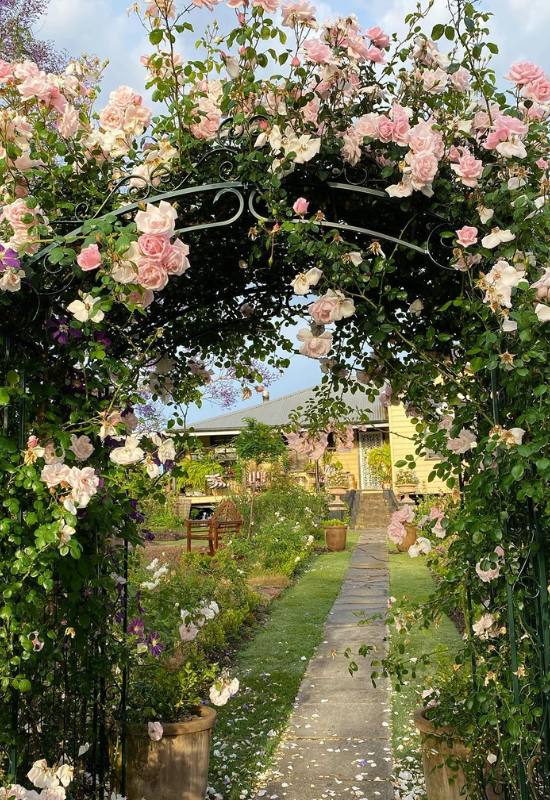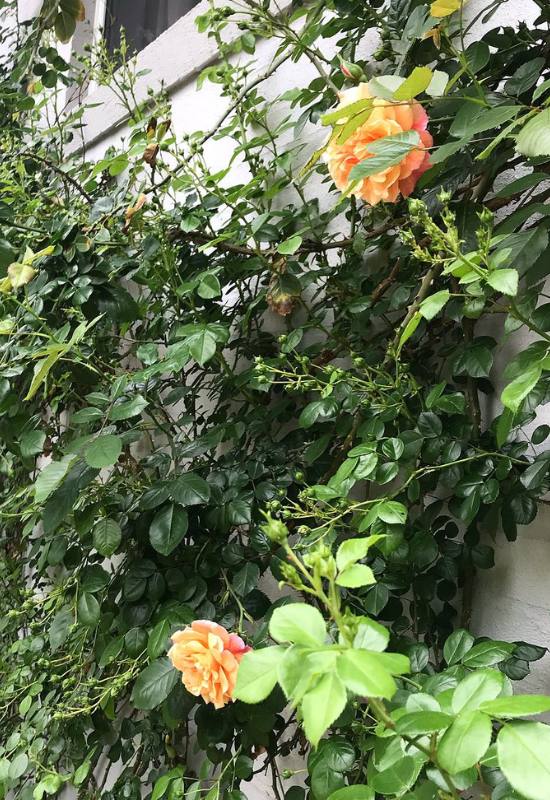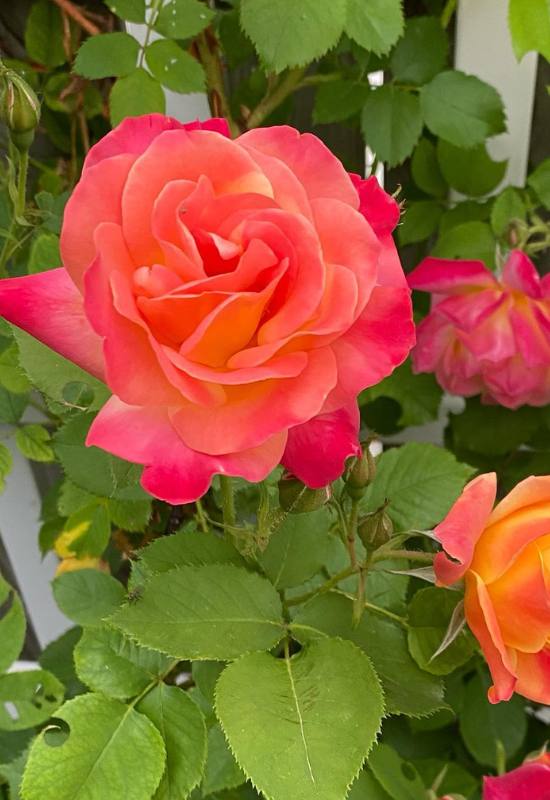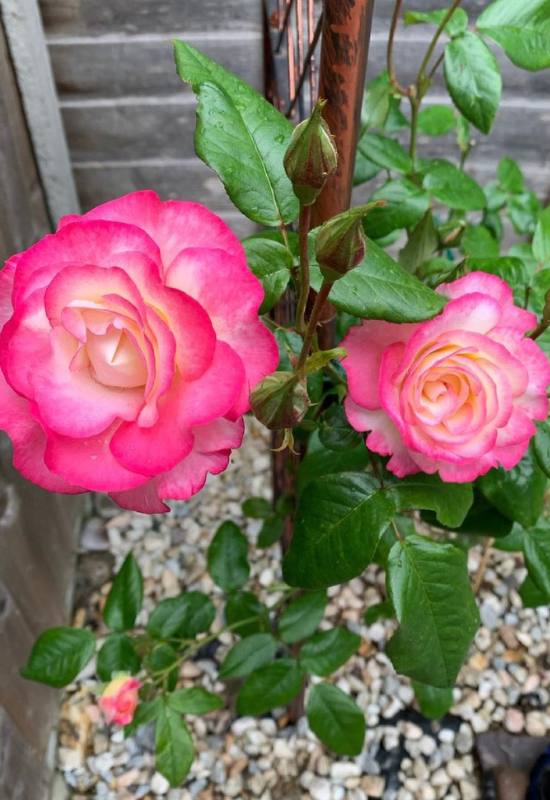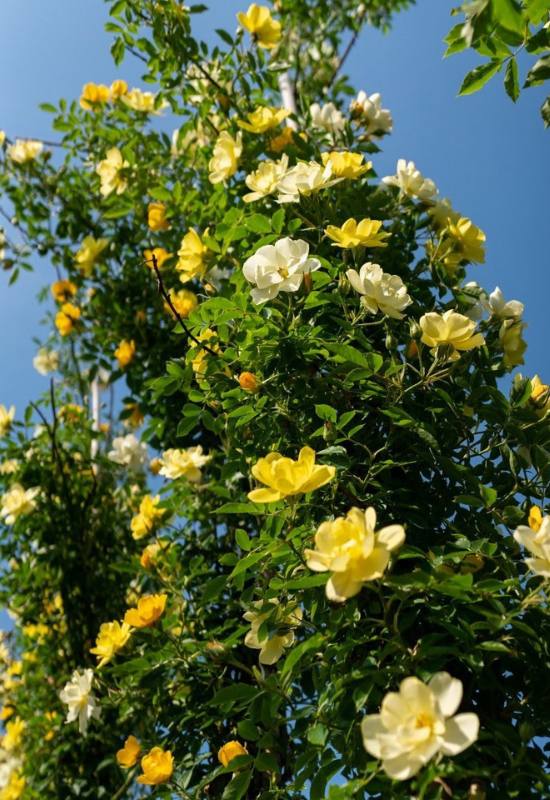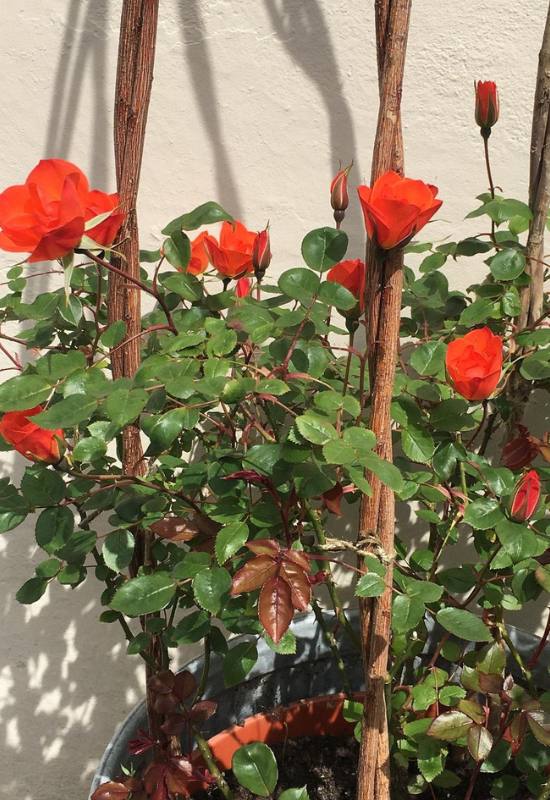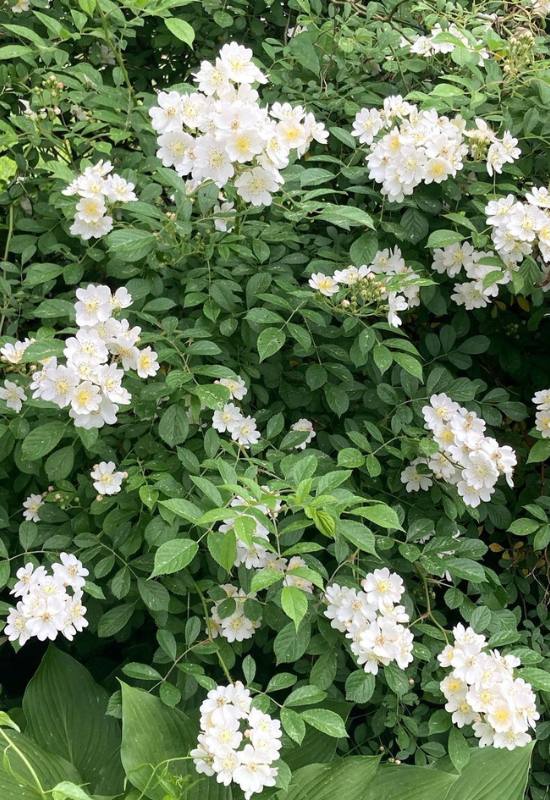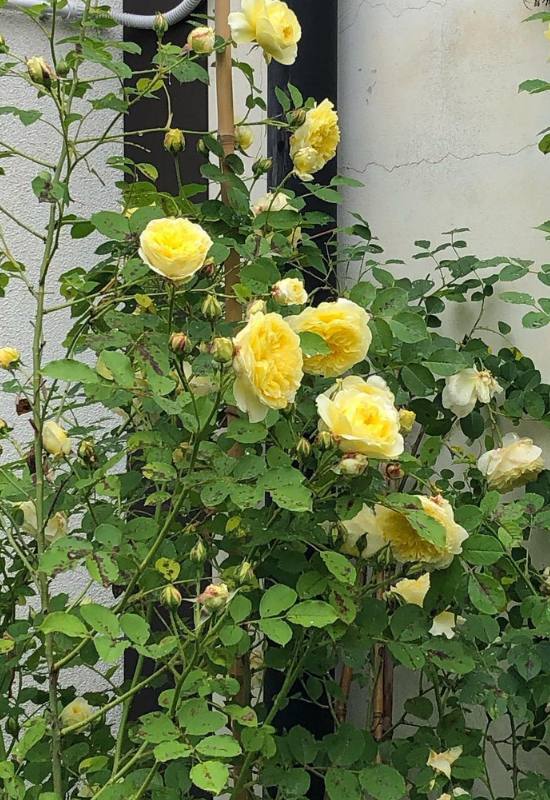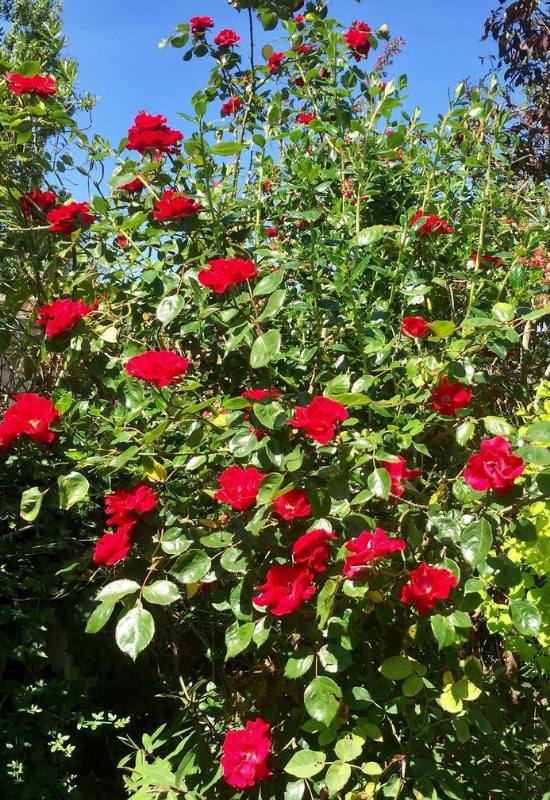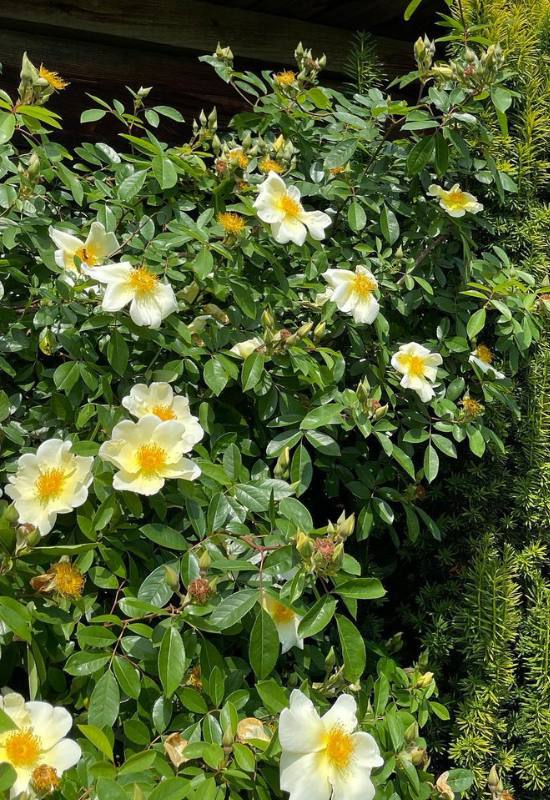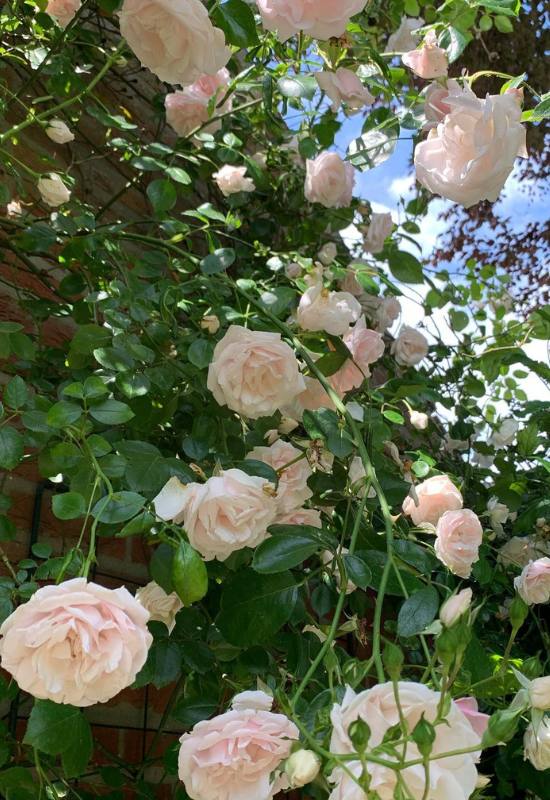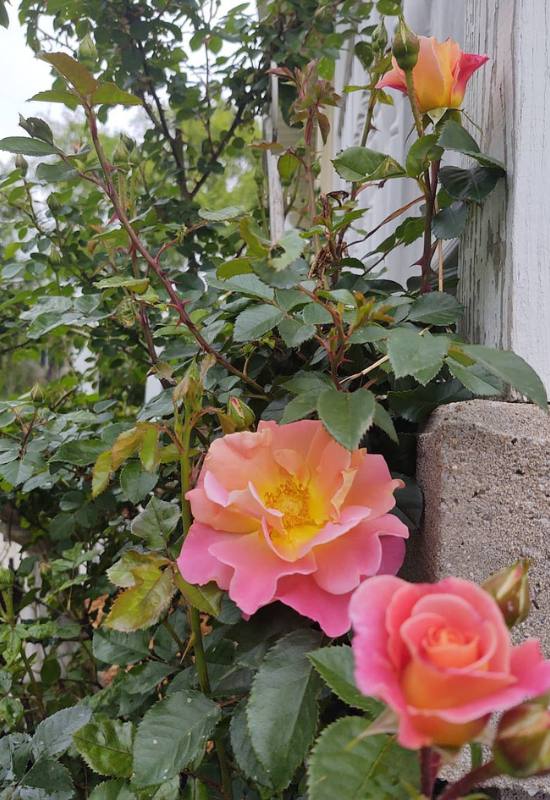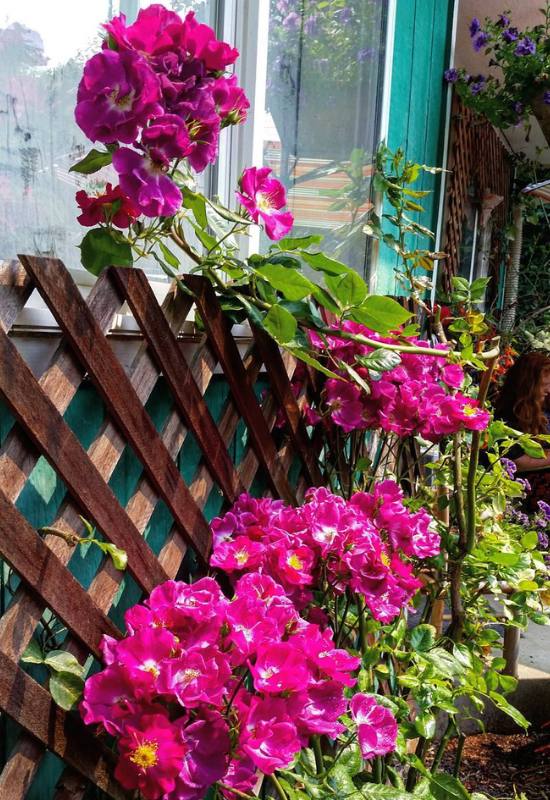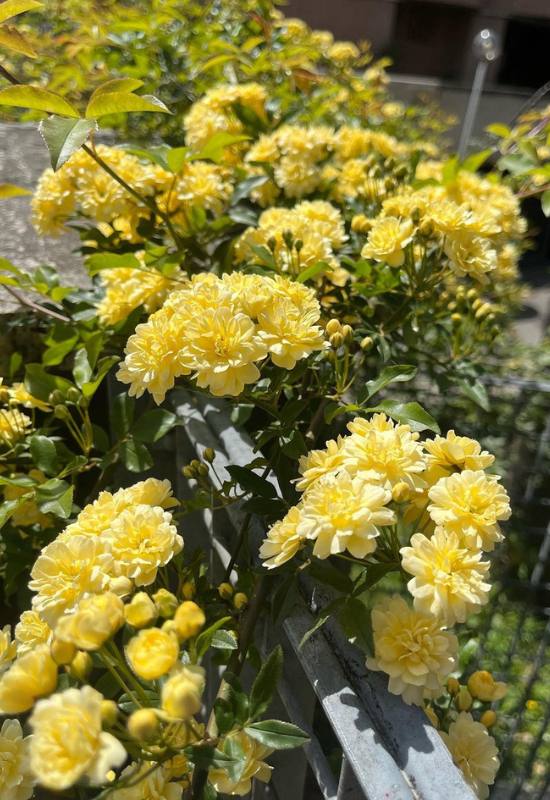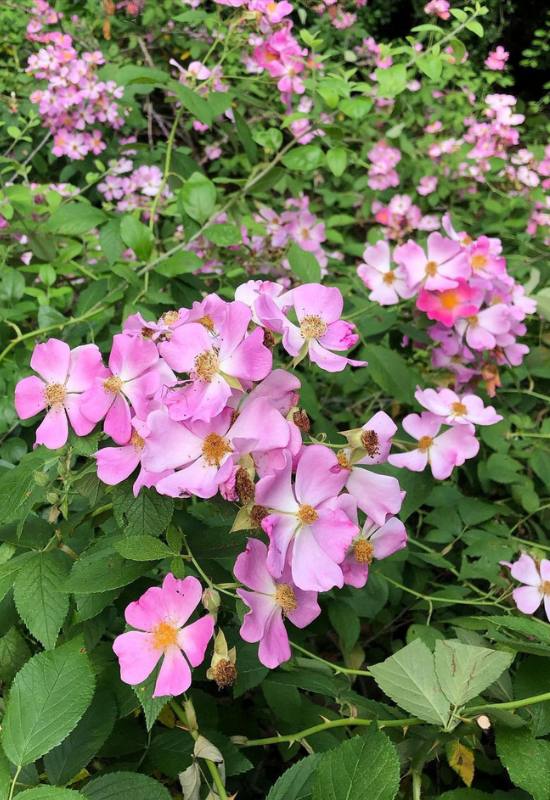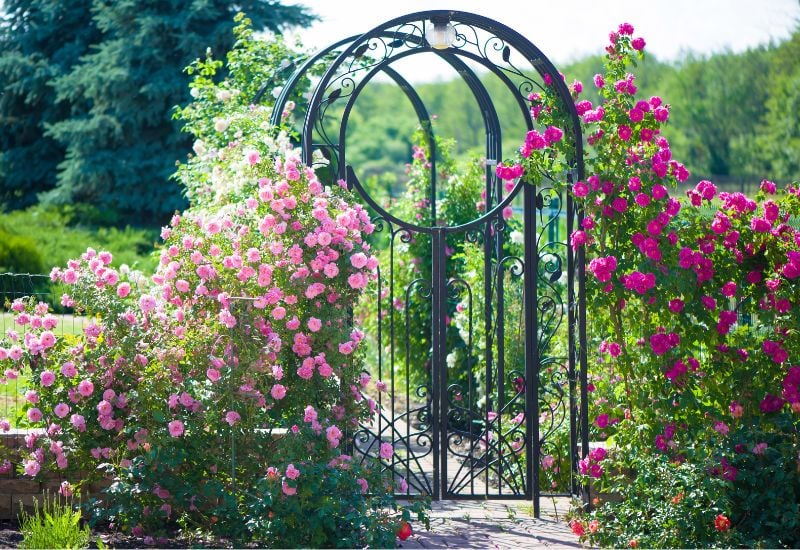
Climbing roses decorate fences, gates, porches, gazebos, walls and facades with their colorful, often sweetly fragrant and long lasting blossoms.
Single or double, with or without thorns, they always give you that picture perfect gardening touch you see in cottages and grand estate homes.
But there are short and large – even giant varieties for any type of garden, including yours.
In fact, these flowering vines are some of your best garden allies: from dividing areas of your land to framing entrances with their blossoms, and even if you want a natural barrier against intruders, including deer…
Not last, the fact that if you want a traditional garden design, you really can’t do without one of these amazing flowering vines.
With such a wide range of varieties, for size, color – from the delicate pastel pink ‘New dawn’to the explosive ‘Jospeh’s Coat’ – and even shape, you need a guide and shortlist of the best and how to use them: so here it is!
A Guide to Stunning Climbing Rose Varieties
There is a huge range of climbing roses, both natural species and especially many cultivars, all different, all beautiful, and here is a selection of the best varieties.
I mentioned that climbing roses are really invaluable in gardening and landscaping. So, before we see them all in detail, a few tips on these amazing flowering vines are necessary.
Climbing roses: what are they?
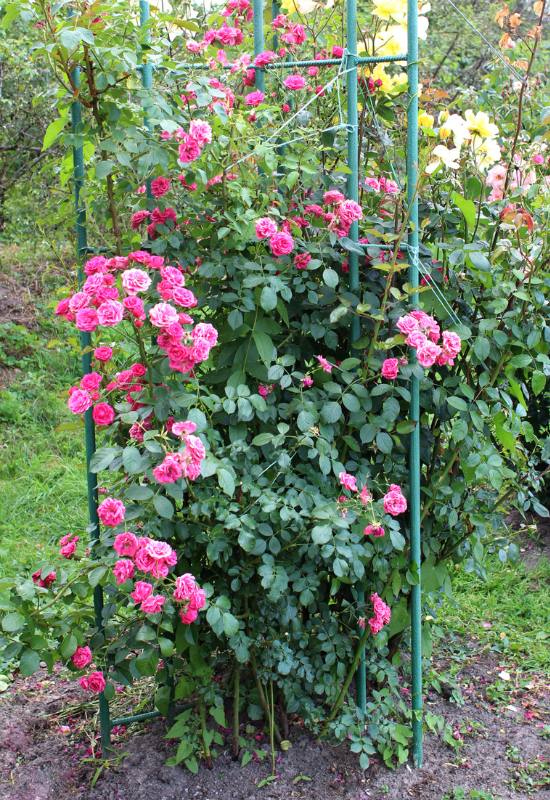
A climbing rose, unlike a shrub variety, will grow long canes that go up on pergolas, trellises and gates.
And this is a key point: they will need some support, or they will simply spread out and become rambling.
You will also need to train them a bit; just as long as you thread the stems into a grate, or indeed a trellis of any type, it will go up and up.
But they have no tendrils or suckers, nor do they twine like vines do. When it is young and the branches are green and flexible, that’s the time to do it.
Once they thicken and harden, most of your training work will be done. After that, it will be mainly a matter of pruning and thinning, so, the first few years are essential to get them to take the shape you want your rose to have.
These are the essentials, but now, let’s find out some great uses of climbing roses.
Garden uses and tips for climbing roses
There are many ways you can use a climbing rose in your garden or yard, in fact, they are very useful indeed. Let me show you why.
Cover Structures Such As Fences, Walls, Trellises, And Arbors
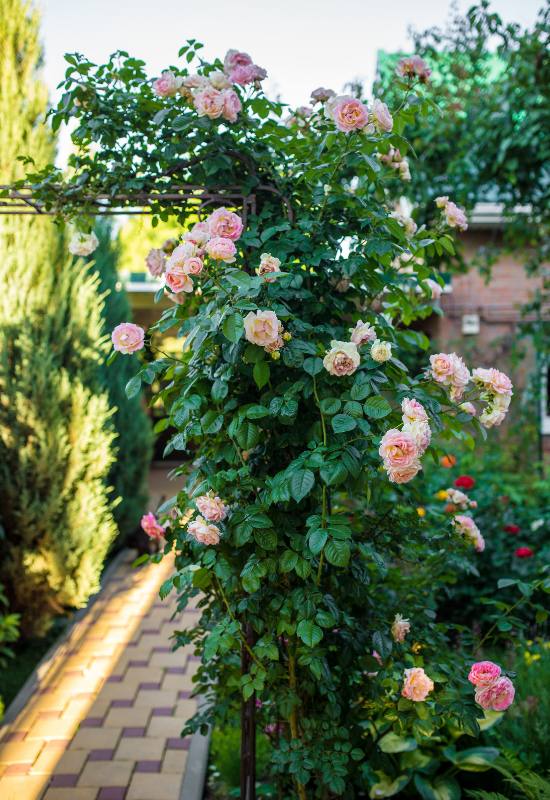
A typical use of climbing roses is to grow them on structures like fences and especially gates. They will make them look beautiful and part of the whole garden, not like external structures.
Given their big blooms, and the great decorative value of roses, but also their high maintenance needs, most people grow them in very prominent places.
A front gate, a main entrance porch, a beautiful gazebo or pergola… These are some of the most common places where climbing roses have their best effect.
But nothing stops you from growing one on the sides of your garden shed or to hide an unsightly back wall.
Add Vertical Dimension in Your Gardens
Because they can grow tall (even very tall as we will see), climbing roses bring color and sometimes even their fragrance high up, above our heads.
This creates that vertical dimension, even accent if you give them a lean and columnar shape, that many gardens really lack.
Just imagine a rose growing on a column or even a simple pillar: you can see how this can literally lead the eye up to its beautiful blossoms, and being able to play with how people view a garden is the hallmark of a good landscape designer.
To Brind the Old World Look
Roses and traditional gardens are almost synonyms. If you like the old world landscaping idea, like in a cottage garden or English country garden, a climbing variety with a profusion of flowers that arches over a gate, or that frames the main entrance of your home, is must have feature.
Talking abut which…
Climbing Roses to Frame Garden Features and Views
What’s more romantic than an arching climbing rose that frames the view of an old and beautiful country town in the distance?
If you want to incorporate an external view into your garden, use a climbing rose to make a decorative, living frame, and what’s outside will become a picture perfect, postcard feature of your own green space.
But even within your property, you can grow climbing roses to frame and decorate a feature, like a statue, a fountain, or even just a bench or table where you can stop and relax on summer days.
Climbing Roses to Define Garden Rooms
The idea of a garden room, a defined space within a garden, is very key to landscaping.
And climbing roses can have a central role in creating them. If your land is big enough, of course, and you wish to divide it into separate spaces…
A climbing rose will surely fit better within the design than a wall or fence, and it will take up less space than a hedge, as they can be kept very thin indeed.
Just build a trellis or any support, let your climbing rose variety of choice grow over it, and you will have a flowering and even fragrant “partition wall”.
Climbing Roses for See Through Effects
There’s an old trick with gardeners… If your garden is not big, and you want to give the impression that it is bigger, especially longer…
Put a trellis halfway to two thirds through the end… Grow a thin vine that you can see through… Your eyes will stop there before moving through it, and your yard will look longer!
The good news is, you can keep climbing roses quite thin, like partial veils, so your visitors can see through the leaves and flowers, but they will also stop on them, and they will subconsciously think they have looked further away when they move ti the back of your garden!
Climbing Roses to Create Perspective
Using climbing roses to create or enhance perspective in your garden could not be easier!
Grow them on posts, pillars, or even better arches and place a pair of plants on each side of your perspective line. Then repeat this further down the view, then again.
Three is enough, but depending on how big and long is your garden, you can go on, virtually forever.
This will lead the viewer’s eye to the focal point, and it will do it with colorful flowers and decorative leaves!
To Make Your Garden Smell Amazing
By “high”, I don’t just mean just strong fragrance, though some are really heady… I mean that if you have a window and when you open it you want to breathe sweet scents, you can train a climbing rose to frame it.
But there is also a more worldly side to this; you can use climbing roses to cover bad smells, from a road, from dust cans and even from your own compost heap or chicken coop.
Now you see how useful climbing roses are for landscaping, let’s see what choice of varieties you have.
15 Climbing rose varieties for your garden
So, each chosen for a particular and sometimes even unique property, we are pleased to show you the very best 15 varieties of climbing roses:
1: ‘Aloha’ Climbing Rose (Rosa ‘Aloha’)
Let’s start with a romantic and classic looking mediumsized climbing rose reaching about 10 feet tall (3.0 meters): the heirloom ‘Aloha’ cultivar.
The large blooms reach 5 inches across (12.5 cm), and they are fully double, with up to 50 petals each.
With a strong fragrance, even in wet weather, the flowers are pink, with a copper hint in the center, with petals arranged in an old world fashion, fairly irregularly.
This free blooming variety also sets off its floral display thanks to the very dark, ash green leaves, which are also quite glossy. Bushy in habit, it can also be grown as a shrub, but it is a classic climber.
‘Aloha’ climbing rose has been gracing romantic and traditional gardens with its super romantic presence since 1949, when it was introduced by Boerner. Since then, it has won the Award of Garden Merit by the Royal Horticultural Society.
2: ‘Joseph’s Coat’ Climbing Rose (Rosa ‘Joseph’s Coat’)
If you want warm and bright, energetic blooms on your trellis or pergola, ‘Joseph’s Coat’ is the climbing rose you need!
Another medium sized variety, it produces clusters of elegant fully double flowers with 26 to 40 petals each, about 4 inches across (10 cm).
The explosion of colors is what makes it striking; starting with pink and red at the tips, the shades brighten up to peach and even yellow as you move to the center.
They are mildly fragrant and they blossom repeatedly from spring to fall. The very thorny branches bear apple green leaves, quite glossy and a perfect backdrop for the floral display.
Eye catching and showy, ‘Joseph’s Coat’ was introduced by Armstrong and Swing in 1963, and it is ideal for pergolas and fences where you want a focal point.
3: ‘Handel’ Climbing Rose (Rosa ‘Handel’)
Vigorous and energetic, ‘Handel’ is a low to medium sized variety of climbing rose full of brightness and light! The blooms have 24 petals, and you can see the golden center, reaching about 3.5 cm across (8.5 cm).
The main effect is due to the bright pink edges set against the white color of the petals themselves.
They have a light aroma as well, and they are late bloomers, ideal for when colors get darker and shadows get longer. The foliage too is packed with solar vibrations, as it is green with copper shades!
‘Handel’ climbing rose is also rain tolerant, which makes it ideal for wet regions, where it can light up your gates, walls, pergolas, trellises and gazebos with its unusual but bright blooms.
4: ‘Golden Gate’ Climbing Rose (Rosa ‘Golden Gate’)
If you want gentle brightness and energy at eye level, have a look at ‘Golden Gate’ climbing rose.
Medium low in height, it has canary yellow blooms, quite refreshing, and about 3.25 inches across (8.0 cm). They are loosely cupped and when open they show the golden center of the blossom.
Fully double, with up to 60 petals each, they are also fragrant, with a fitting citrus smell. Free flowering till late in the season, it also has unusual foliage… In fact, the leaves are mid green, but leathery, which is not common with rose varieties.
If I had to define ‘Golden Gate’ with a single adjective to help you in your choice it would be “invigorating” or “refreshing” or “uplifting”.
Full of positive energy and winner of the Award of Garden Merit by the Royal Horticultural Society, this climbing cultivar was introduced by Tim Hermann Kordes in 1995.
5: ‘Warm Welcome’ Climbing Rose (Rosa ‘Warm Welcome’)
A low but emotionally charged climber, ‘Warm Welcome’ is a very intense but also elegant looking rose cultivar.
The semi double blooms start off deeply cupped, almost like hybrid tea varieties. As they open, they become fully flat, showing you the golden stamens.
The petals shade from light red orange to coral, making them both passionate and very refined. With 9 petals each, they are also mildly fragrant.
Set against dark green leaves with a copper blush, they make a heart warming and eye catching floral display till the end of the season.
Introduced in 1992 by Christopher H. Warner, ‘Warm Welcome’ climbing rose has since win the Award of Garden Merit by the Royal Horticultural Society. Ideal for short trellises, fences and gates, it can also have a role at the back of borers.
6: Multiflora Rose (Rosa multiflora)
For a natural woodland look, multiflora rose, a natural species from East Asia will be a perfect choice.
This tall climber, reaching 15 feet feet in height (4.5 meters) is very vigorous and florid, offering your garden clusters of fragrant single white flowers with 5 dented white petals, that look a bit like Malta crossed.
Followed by small but long bright red hips, they come abundantly at the tips of the canes. The foliage is quite original as well.
Each leaf is divided into 7 to 9 toothed leaflets, not 5, and they are mid green in color. A magnet for small fauna and birds, this is a great variety for large, naturalized areas.
In fact, multiflora rose can even become invasive, as it reproduces spontaneously and quite fast.
You can even use it to have a natural fence around your property, using its thick habit and thorns to keep intruders (and deer) away. But you can also train it to climb up even tall fences and gates.
7: ‘Marigold’ Climbing Rose (Rosa ‘Marigold’)
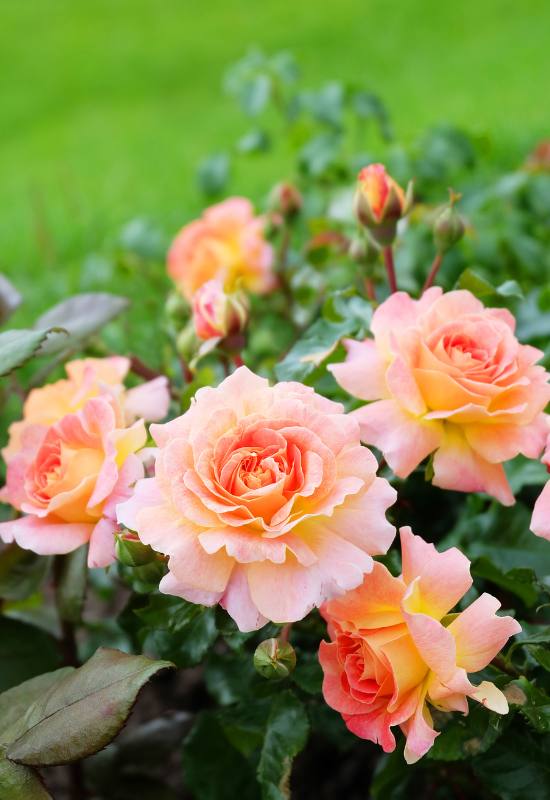
‘Marigold’ is an outstanding medium low climbing rose variety with a very delicate palette. The deeply cupped, semi double blooms are masters of shading…
They have refined and sophisticated hues of rose pink, bronze, peach and coral that fade into each other with extreme panache!
Reaching 4 inches across (10 cm), they come generously in clusters starting in summer. Set against the dense, glossy mid green and toothed foliage on arching stems, they are like a work of art indeed! What’s more, is one of the few cultivars that like shady gardens.
‘Marigold’ brings both romance and great sophistication of colors and shapes to your pergolas or trellises.
It is also an heirloom cultivar introduced by Reimer Kordes in 1953 and a winner of the Award of Garden Merit by the Royal Horticultural Society.
8: ‘The Pilgrim’ Climbing Rose (Rosa ‘The Pilgrim’)
A medium sized climber with bright blooms is ‘The Pilgrim’ a recent cultivar with large, soft yellow blooms.
The fully double flower heads, 4 inches across (10 cm) are so packed with petals that it’s hard to count them.
Shallow cupped, or bowled, the color starts off as off white at the edges and it turns butter yellow as you move towards the center.
They also charm you with their balanced, myrrh and tea fragrance. The lush mid green leaves, healthy, make a wonderful backdrop for the repeated floral displays.
Bred by David Austin in 1991, ‘The Pilgrim’ climbing rose is a shade tolerant variety for most uses, from pillars to gates, porches and pergolas.
9: ‘Parkdirecktor Riggers’ Climbing Rose (Rosa ‘Parkdirektor Riggers’)
The heirloom tall variety of climbing rose you want if you like super bright and powerful colors is ‘Parkdirektor Riggers’.
Blooming profusely through the warm season, this climber in fact has blood red blossoms, of a shade that it’s hard to believe!
The golden center only makes the blossoms even more eye catching. Energetic and passionate, this floral display is set against dark green, dense foliage.
This is also the ideal cultivar to grow against a north facing wall, as it is more shade tolerant than most roses.
So, bring some heat and energy even to shady corners of your garden, on trellises, walls or pergolas in a fresh spot! For this, you need to thank Kordes, who introduced it to gardening back in 1957.
10: ‘Mermaid’ Climbing Rose (Rosa ‘Mermaid’)
A giant variety, strong vigorous and natural looking is ‘Mermaid’ climbing rose. This cultivar is all on a large scale, actually.
The single flowers are 5 inches across (12.5 cm) and they come from spring to fall! They have a lovely primrose yellow color, very bright and almost white.
Popping out of the dark green, glossy and lush foliage, they give you a strong contrast, together with their delicate fragrance.
The shiny foliage is evergreen in mild climates, a very unusual feature, and the stems, filled with thorns, are reddish in color, offering your garden yet another chromatic twist. It also performs well in shady spots, and it is a very healthy plant indeed.
Winner of the Award of Garden Merit by the Royal Horticultural Society, this heirloom climbing rose, ‘Mermaid’ was introduced back in 1909 by William Paul and Son, and it is ideal for big jobs and large spaces.
11: ‘New Dawn’ Climbing Rose (Rosa ‘New Dawn’)
‘New Dawn’ has both a vibrant and a romantic side to its personality. A medium sized to tall heirloom variety, it offers a long season of bright rose green flowers, cupped and semi double, about 3.5 inches across (8.5 cm) and nodding gently from the branches.
They will also please you for their sweet fragrance, and of course, they will be followed by bright red hips.
The glossy dark green foliage completes the effect, setting off the luminosity of the blossoms with perfection.
Yet another winner of the Award of Garden Merit by the Royal Horticultural Society, ‘New Dawn’ climbing rose was bred by Dr. W. Van Fleet in 1930 with a romantic but bright and cheerful garden in mind.
12: ‘Fruity Petals’ Climbing Rose (Rosa ‘Fruity Petals’)
It’s hard to match the fusion of brightness and delicate colors you find in ‘Fruity Petals’, a low sized climbing variety. Saying it shines with its own light is not an exaggeration.
Just look at the semi double flowers, with bright coral pink petals, about 18 of them, and a vibrant yellow center where you find copper stamens.
The effect is that of a hallucinogenic spotlight, decorated by the frilled, lobed and dented margins.
Each blossom is about 3 inches across (3.5 cm) and cupped, and you will see new ones coming from spring to frost! Unusually healthy and glossy dark green leaves complete the ensemble.
Ideal for a focal point, like a small column, or a low trellis in a visible point, ‘Fruity Petals’ is a newcomer among climbing rose cultivars, only introduced in 2005 by William J. Radler.
13: ‘Stormy Weather’ Climbing Rose (Rosa ‘Stormy Weather’)
‘Stormy Weather’ is average when it comes to size, in fact it is a medium climbing rose, but not when it comes to its blooms.
Not very large, only 2 to 3 inches across (5.0 to 7.5 cm), they come in great numbers throughout the season, in clusters that also have a light but pleasant fragrance.
Yet the most striking quality of this variety is the color of the single flowers, your eye us drawn to the golden center on display, but the bright smoky magenta purple petals are the real protagonists!
The leaves are large, matte and mid green, unusually leathery for the most famous flowering genus in the world.
Easy to propagate and strong, this massive bloomer we call ‘Stormy Weather’ climbing rose is a young cultivar for most medium sized arbors, pergolas, walls and trellises, introduced in 2010 by French breeder Pierre Orard.
14: ‘Lutea’ Lady Banks’ Climbing Rose (Rosa banksiae ‘Lutea’)
Maybe the most impressive bloomer among climbing roses is the large sized ‘Lutea’ Lady Banks’ rose!
The dark and thornless canes literally fill with flowers for months on end – so much, in fact, that the floral display is all you see!
Frilly and fully double, the blossoms are about ¾ inch wide, (2.0 cm), so small, and of a very bright pale yellow shade.
But the effect is given by their huge number. Originally a rambler that you can easily train to climb, it has small, mid green leaves with smooth edges, and in warm climates, these are evergreen, so you will enjoy them in winter as well.
‘Lutea’ Lady Banks’ climbing rose is also easy to propagate by stem cuttings, and it has won the Award of Garden Merit by the Royal Horticultural Society. It is also considered one of the best varieties for dry gardens.
15: Prairie Rose (Rosa setigera)
Let’s finish with a native species from North America, rambling and climbing prairie rose!
While in nature it will drape over shrubs, it will climb up fences and trellises in your garden. Vigorous and healthy, it has fragrant blooms that change color over time.
In fact, the single flower arebright and pale mauve when they open, with golden stamens at the center.
But as ti e goes by, they turn snow white, so you get blossoms of two completely different color on the same plant!
They are about 2 inches across (5.0 cm) and they come repeatedly throughout the season. The bright red hips that follow them are loved by birds.
The woody vines have dark green leaves, but they too change color, taking on purple blushes in fall.
Prairie rose is a perfect and strong climbing variety for natural looking, traditional and even naturalized gardens.
It is quite vigorous and you can even grow it as a rambler to keep unwanted visitors, human and animal (like deer) away.
Climbing roses for amazing gardens
We now come to the conclusion of this journey in the company of climbing rose varieties. To start with, now you know how useful they are in gardening and especially landscaping.
And now you have also met some really amazing varieties, of all colors, double and single, natural and cultivars, for sunny spots and part shade, big and small! I can only leave you with a question then: which one is your favorite?

Written By
Adriano Bulla
After many years as an academic in London, Adriano Bulla became a writer, publishing books like A History of Gardening, Organic Gardening and Elements of Garden Design; he then decided to become a gardener, following his childhood dream, and has been following his dream writing and gardening professionally in Southern Europe, where he has specialized in new and innovative organic gardening fields and techniques, like permaculture, regenerative agriculture, food forests and hydroponics.

